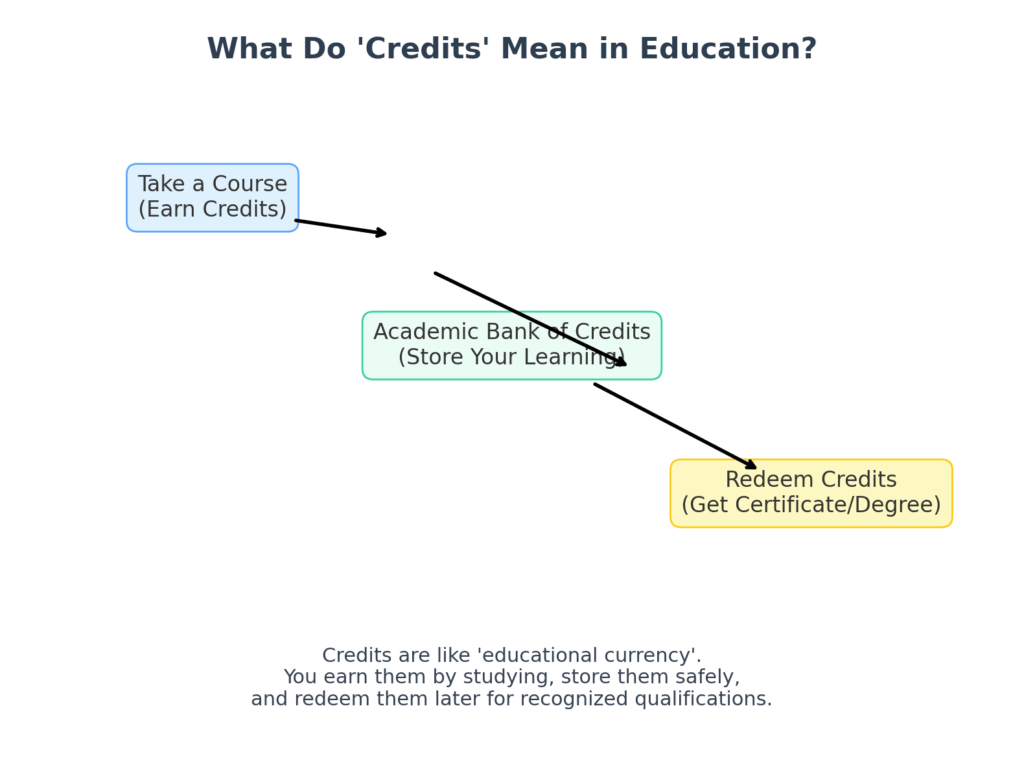What is Credit Banking and Flexible Exits?

This term comes from India’s National Education Policy (NEP 2020).
And they’re also linked with online learning platforms like SWAYAM and the National Digital University.
🔹 Credit Banking
Think of it like a digital wallet for your education.
- Every time you complete a course (online or offline), you earn credits.
- These credits are stored in a central system called the Academic Bank of Credits (ABC).
- Later, you can “redeem” these credits to complete a degree, diploma, or certificate—even if you studied at different institutions.
👉 Example: You finish 2 courses on SWAYAM (say, Data Science and Business Analytics). You earn credits, store them in ABC, and then use them toward your MBA or MSc at a university that accepts those credits.
🎓 What are “Credits” in Education?
- A credit represents the weight or value of a course.
- It shows how much learning effort you’ve put into that subject.
- In India, under UGC guidelines, usually 1 credit = 1 hour of lecture per week (or 2 hours of practicals) for a semester.
👉 Example:
- A small online course might be worth 2–4 credits.
- A full-semester subject in college might be worth 6–8 credits.
💳 Credit Banking (Why It’s Called That)
The Academic Bank of Credits (ABC) stores your earned credits, like a digital account.
- You “deposit” credits whenever you complete an approved course (like on SWAYAM, NPTEL, or at your university).
- Later, you can “withdraw” or use those credits to get a certificate, diploma, or degree.
So, credits are not money, but they behave like educational currency 💡.
👉 In short: Earning credits = collecting official proof of learning that can be combined with other credits to complete a larger qualification.

🔹 Flexible Exits
This is about giving students freedom to pause or leave their degree program without losing progress.
- If you complete 1 year of a program, you can exit with a certificate.
- After 2 years, you might leave with a diploma.
- If you complete all 3 or 4 years, you get the full degree.
👉 Example: Suppose you joined a 4-year engineering program. But after 2 years, you decide engineering isn’t your path. Instead of leaving empty-handed, you walk away with a diploma certificate that still has value in the job market.
✅ In short:
- Credit banking = Store and use your learning like digital money.
- Flexible exits = Take your learning in smaller chunks, and leave with something useful at every stage.
Here’s what to read next
Career Guide: What After 10th Grade in India
Best Career Options After 12th Science in 2025
What Is a Proctored Exam and How Does It Work?
Frequently Asked Questions
What is credit banking in education?
Credit banking is like a digital wallet for your learning. Whenever you complete an approved course (online or offline), you earn credits. These credits are stored in the Academic Bank of Credits (ABC), and you can use them later to complete a certificate, diploma, or degree.
What are flexible exits in degree programs?
Flexible exits mean you don’t lose your progress if you leave a program midway. For example, if you complete:
- 1 year: You can exit with a certificate.
- 2 years → You get a diploma.
- 3–4 years: You earn the full degree.
This system ensures that every stage of your learning has value.
What is a multiple entry and exit academic bank of credit?
Under India’s National Education Policy (NEP 2020), students don’t have to feel “stuck” in a course anymore.
The idea of multiple entry and exit means you can:
- ✅ Enter a degree program, pause if needed, and come back later.
- ✅ Exit a program at different stages, but still leave with a valid qualification.
👉 Example:
- After 1 year → Exit with a Certificate.
- After 2 years → Exit with a Diploma.
- After 3 years → Exit with a Bachelor’s Degree (in some programs).
- After 4 years → Complete the Honours/Research Degree.
So, instead of dropping out with nothing, you carry something valuable with you at each stage.
What is the UGC exit policy?
The UGC Exit Policy comes from the University Grants Commission (UGC) under the National Education Policy (NEP) 2020.
It allows students in higher education (especially in undergraduate programs) to leave a course at different stages without losing their academic progress. Instead of walking away empty-handed, you get a qualification for the years you’ve completed.
What is multiple entry and exit?
Multiple Entry and Exit is a feature of India’s National Education Policy (NEP 2020) that makes college and university study more flexible.
Traditionally, if a student left a degree midway, all the time and effort were wasted. With the new system, students can enter, leave, and re-enter a program at different stages and still carry forward what they’ve already completed.






